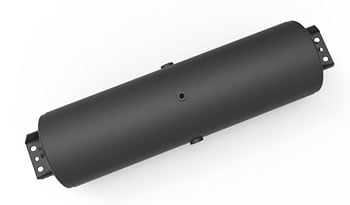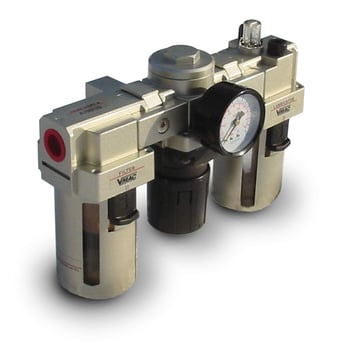Compressed Air Treatment Methods
Mobile compressed air is used to power various tools and equipment, and there are many compressor styles to choose from. However, a common challenge with all air compressor systems used in mobile applications is delivering cooled air with minimal contamination from particulates, moisture, and oil carry-over.
This article will discuss the three types of contaminants that must be treated for—moisture, oil, and particulates—as well as popular compressed air treatment methods for each.
Treating For Moisture/Water
Moisture in the form of water is a natural byproduct of compressing air, caused by the temperature changes during the compressor process. While this water is natural and small amounts are okay, it’s crucial to filter most of it out to prevent irreversible damage to the mobile air compressor system and air tools.
Air-Cooled Aftercooler
 An air aftercooler is a heat exchanger used to cool compressed air. Reducing the compressed air temperature causes moisture to precipitate out of the air, which are collected and drained off with a moisture separation device and drain trap.
An air aftercooler is a heat exchanger used to cool compressed air. Reducing the compressed air temperature causes moisture to precipitate out of the air, which are collected and drained off with a moisture separation device and drain trap.
The air-cooled aftercooler looks very much like a car radiator, and acts like one as well. However, rather than water filling the interior, the hot compressed air enters the bottom of the air-cooled aftercooler and travels within a tube system, discharging through the upper discharge port into a moisture separator. The tubes have fins, or metal plates between them, to increase their surface area and dissipate the heat more effectively.
A heat transfer occurs between two bodies of different temperature until temperature equilibrium is reached. This transfer of heat takes place in three different ways:
- Conduction
- Convection
- Radiation
Generally, these occur simultaneously.
As heat from the compressed air meets the cooler ambient air, some of the heat of compression is removed from the compressed air and blown away by the fan. For the best outcomes, the aftercooler should be located as close as possible to the compressor air outlet.
Air Receiver Tanks
 All air compressor applications benefit from using air receiver tanks. It is generally accepted that no receiver is too large for an application and no number of receivers are too many.
All air compressor applications benefit from using air receiver tanks. It is generally accepted that no receiver is too large for an application and no number of receivers are too many.
The air receiver tank serves many important functions:
- Acts as a reservoir to take care of sudden or unusually heavy air demands in excess of the compressor capacity.
- Prevents too frequent cycling of the compressor.
- Dampens pulsations from the discharge line of a reciprocating compressor, resulting in essentially steady pressure in the system.
- Precipitates some of the moisture that may be present in the air as it comes from the compressor or that may be carried over from the aftercooler.
The minimum air receiver tank capacity for certain applications may be calculated, but experience and judgment are just as important. Whether a vertical or horizontal receiver tank is used only depends on physical space available.
As soon as air leaving the aftercooler enters the receiver tank it comes in contact with the cooler steel wall of the tank, which is usually at ambient temperature. At this point, moisture starts to condense out of the compressed air and into the air receiver tank as the air chills.
Even if the compressor is supplied with an air-cooled aftercooler, the temperature of the discharged air is always higher than the ambient air temperature because aftercoolers are not 100 percent efficient.
If the air is stored in the tank for enough time, the temperature of the air in the tank will be the same as the ambient temperature, and no more moisture will condense out. At this point the air in the receiver tank is 100% saturated at a dewpoint equal to ambient temperature.
As a downside, the storage of moisture in receiver tanks leads to the formation of rust and scale on the inside of the tank, which can become loose and get carried down-stream in the outgoing air. This rust and scale can cause premature blockages in filters and cause problems in down-stream components.
Treating For Dry Particulates
Research has shown that every cubic meter of air in industrial areas contains about 140 million dirt particles. In heavy industrial areas the problem is even worse. Furthermore, up to 80 % of this contamination is smaller than 2 micron, allowing it to pass straight through the compressor intake filters, which range between 5 -10 microns.
Compress this air to 100 psig, and you have a staggering 980 million dirt particles per cubic meter, not to mention oil, dirt, scale, rust, and condensed moisture.
Dirt and other contamination can have a serious effect on the wear and efficiency of pneumatic machinery. It will increase maintenance, downtime, and replacement cycles.
Air Filters
 Air filters use dry particulate filtration, which relies on three mechanical separation mechanisms:
Air filters use dry particulate filtration, which relies on three mechanical separation mechanisms:
- Direct interception
- Inertial impact
- Diffusion or Brownian movement
Direct interception catches the larger particles in an air stream and literally sieves them out. These particles present no real problem other than clogging filter material.
Inertial impact is used to contain smaller particles that can’t change direction as quickly as the air. These particles may deflect around the first, second, or even third fiber in the filter material, but eventually get caught in the complex path between fibers.
Brownian movement is used to target very fine particles using inter-molecular and electrostatic forces. These forces cause the particles to spiral within the air, essentially increasing their diameter so they are caught by the filter fibers.
Common Types of Air Filters
There are four common types of air filters found in mobile air compressor systems. Three are used to filter air during intake, before it’s compressed, and one is used to filter air after compression.
Before Compression
- Standard Air Filters – Removes contaminants from the compressed air
- Heavy Duty Air Filters – Used in areas with high contamination, such as industrial job sites, to remove particulates
- Air Cyclones – Often combined with a heavy duty air filter & uses cyclonic movement to knock out large dry particles
After Compression
- Filter Regulator Lubricators – Removes particulate contaminants while adding atomized tool oil into the compressed air stream
Treating For Oil Carryover
Oil-injected air compressors use oil to lubricate components and create a seal within the compression chamber. After the air is compressed, oil is removed from the air stream using air-oil separator tanks and coalescing filters.
It is completely normal for small amounts of oil to carryover into the compressed air during this process. However, this oil needs to be filtered back out to protect the compressor system and air tools. The most common ways to filter oil in a mobile air compressor system is with a filter regulator lubricator or a coalescing filter.
 Filter Regulator Lubricators
Filter Regulator Lubricators
A Filter Regulator Lubricator (FRL) unit combines three crucial functions: filtration, regulation, and lubrication, into a single, compact assembly. FRLs help maintain optimal performance, protect equipment, and extend the lifespan of air tools. The “Filter” portion of the Filter Regular Lubricator is sometimes a coalescing filter that removes oil particles, as well as dirt and dust particles, from the compressed air.
Coalescing Filters
 With coalescing filters, air enters through the inlet port and travels down through the inner core of the filter, passes through the filter media and exits through the discharge port. Moisture and oil collect in the bottom of the housing and are expelled by a condensate drain valve, and other solid contaminants collect in the filter element.
With coalescing filters, air enters through the inlet port and travels down through the inner core of the filter, passes through the filter media and exits through the discharge port. Moisture and oil collect in the bottom of the housing and are expelled by a condensate drain valve, and other solid contaminants collect in the filter element.
This type of a filter frequently has a built-in, float-type auto drain trap and some manufacturers have a moisture level sight glass mounted on the side. This is to provide visual assurance that the moisture drain is functioning.
The coalescing type filter show in the diagram below is typical of a low capacity coalescing type filter. The flow pattern is the same as that of larger filters, however the filter media sometimes has an anti-re-entrainment barrier on the outside of the filter cartridge to prevent liquid contaminants from getting picked up by the outgoing, clean airflow.

Compressed Air Treatment Requirements
How compressed air is used directly impacts the type and number of contaminants that are allowed. For example, air tools can tolerate a much higher level of particulate contamination than food or medical applications.
The typical grades and specifications of filtration are:
| Types of Filters | Particulate (General Shop Air) |
Oil Removal Coalescing (Instrument Air) |
Extra Fine Oil Removal Coalescing (Food Industry) |
|---|---|---|---|
| Liquid Removal | 100% of Water | 99.99=% of Oil | 99.99=% of Oil |
| Max. Liquid Loading | 2000 ppm w/w | 1000 ppm w/w | 100 ppm w/w |
| Solid Particulate Removal | 1 micron | 0.01 microns | 0.01 microns |
| Oil Carry-over | 1 ppm w/w | 0.01 ppm w/w | 0.001 ppm w/w |
| Pressure Drop | Dry: 1psi Wet:2 psi | Dry: 1psi Wet:3 psi | Dry: 2psi Wet:6 psi |
Regardless of your specific tool or equipment, treating your compressed air before it reaches your application will benefit your job and the longevity of your valuable assets. Therefore, effective compressed air treatment should be a crucial consideration for every compressor.
